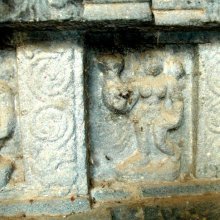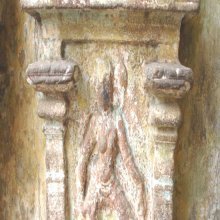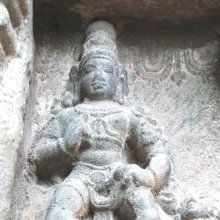Carin, Cari, Cārin, Cārī, Carī: 34 definitions
Introduction:
Carin means something in Buddhism, Pali, Hinduism, Sanskrit, Jainism, Prakrit, the history of ancient India, Marathi, Hindi, biology, Tamil. If you want to know the exact meaning, history, etymology or English translation of this term then check out the descriptions on this page. Add your comment or reference to a book if you want to contribute to this summary article.
Alternative spellings of this word include Chari.
Images (photo gallery)
(+113 more images available)
In Hinduism
Natyashastra (theatrics and dramaturgy)
Source: Wisdom Library: Nāṭya-śāstra1) Cārī (चारी) refers to a “dance step”, according to the Nāṭyaśāstra chapter 11. The simultaneous movement of the feet (pāda), shanks (jaṅghā) and the hip (ūru) is called a cārī. According to Nāṭyaśāstra 10.52, “For in the movement of feet are included all the movements of shanks and thighs.”
There are on total thirty-two cārīs defined, of which sixteen classified as earthly (bhaumī):
- samapādā,
- sthitāvartā,
- śakaṭāsyā,
- adhyardhikā,
- cāṣagati,
- vicyavā,
- eḍakākrīḍitā,
- baddhā,
- ūrūdvṛttā,
- aḍḍitā,
- utsyanditā,
- janitā,
- syanditā,
- apasyanditā,
- samotsaritamatalli,
- matalli.
And sixteen cārīs are classified as aerial (ākāśikī):
- atikrāntā,
- apakrāntā,
- pārśvakrāntā,
- ūrdhvajānu,
- sūcī,
- nūpurapādika,
- dolapādā,
- ākṣiptā,
- āviddhā,
- udvṛttā,
- vidyudbhrāntā,
- alātā,
- bhujaṅgatrasitā,
- hariṇaplutā,
- daṇḍā,
- bhramarī.
These are divided within four different classes:
- cārī (movement with a single foot),
- karaṇa (two feet moving together),
- khaṇḍa (combination of three karaṇas),
- maṇḍala (combination of three or four khaṇḍas).
2) Cārī also refers to one of the ten practices performed after the removal of the stage curtain, according to the Nāṭyaśāstra chapter 5. Accordingly, “The cārī is so called because it consists of movements depicting the Erotic Sentiment (śṛṅgāra).”.
Performing the cārī preliminary pleases Umā. According to Nāṭyaśāstra 5.57-58, “The performance of the Preliminaries which means worshipping (pūjā) the gods (devas), is praised by them (i.e. gods) and is conducive to duty, fame and long life. And this performance whether with or without songs, is meant for pleasing the Daityas and the Dānavas as well as the gods.”
Source: Shodhganga: Elements of Art and Architecture in the Trtiyakhanda of the Visnudharmottarapurana (natya)Cārī (चारी) refers to the “delicate movements of limbs”, according to the Viṣṇudharmottarapurāṇa, an ancient Sanskrit text which (being encyclopedic in nature) deals with a variety of cultural topics such as arts, architecture, music, grammar and astronomy.—Cārī makes a dance performance more elegant and attractive. On the other hand when the movements are forceful, then these are called as mahācārī. The Viṣṇudharmottarapurāṇa does not talk about the types of cārī. But according to the Nāṭyaśāstra, there are thirty two kinds of earthly cārīs and sixteen kinds of aerial cārīs. Again the Abhinayadarpaṇa accepts eight klinds of cārī. The names and definitions of cārīs in both of these works are totally different and do not have any similarity.

Natyashastra (नाट्यशास्त्र, nāṭyaśāstra) refers to both the ancient Indian tradition (shastra) of performing arts, (natya—theatrics, drama, dance, music), as well as the name of a Sanskrit work dealing with these subjects. It also teaches the rules for composing Dramatic plays (nataka), construction and performance of Theater, and Poetic works (kavya).
Shaivism (Shaiva philosophy)
Source: Brill: Śaivism and the Tantric TraditionsCārin (चारिन्) refers to “one who walks (the path of the wind)” [?], according to the Guhyasūtra chapter 3.—Accordingly, “[...] [Using the mantra] ‘oṃ namo vāyupathacāriṇe amitagatiparākramāya vimale kulu kulu svāhā’, [and taking] arsenic, gold [and?] a mineral, …, ground up with pig fat/marrow, over which one has recited [the navātman] 1000 times, he should smear [the mixture] on his feet/legs, while once again reciting the navātman: he will travel 200 yojanās unwearied!”.

Shaiva (शैव, śaiva) or Shaivism (śaivism) represents a tradition of Hinduism worshiping Shiva as the supreme being. Closely related to Shaktism, Shaiva literature includes a range of scriptures, including Tantras, while the root of this tradition may be traced back to the ancient Vedas.
Shaktism (Shakta philosophy)
Source: Google Books: ManthanabhairavatantramCārin (चारिन्) (Cf. Cāriṇī) refers to “one who moves”, according to the Manthānabhairavatantra, a vast sprawling work that belongs to a corpus of Tantric texts concerned with the worship of the goddess Kubjikā.—Accordingly, “Camuṇḍā (the sixth Mother) moves without motion (acāra-cāriṇī) and, mounted on the path of movement and rest, she resides in the end of the End of the Sixteen. Carcikā resides there”.

Shakta (शाक्त, śākta) or Shaktism (śāktism) represents a tradition of Hinduism where the Goddess (Devi) is revered and worshipped. Shakta literature includes a range of scriptures, including various Agamas and Tantras, although its roots may be traced back to the Vedas.
Purana and Itihasa (epic history)
Source: archive.org: Shiva Purana - English TranslationCārin (चारिन्) refers to “those (Gaṇas) belonging to a particular world”, according to the Śivapurāṇa 2.3.40 (“The Marriage Procession of Śiva”).—Accordingly, as Brahmā narrated to Nārada: “[...] The leaders were as refulgent as Brahmā, Viṣṇu and Indra, Aṇimā and other Energies. They were as brilliant and lustrous as crores of suns. O sage, some of them belonged to this terrestrial world (pṛthivī-cārin), some came through nether worlds (pātāla-cārin), some came through the sky and some came through seven heavens. Of what avail is this talk? O celestial sage, Śiva’s own Gaṇas living in all the worlds came and joined the procession of Śiva, with pleasure. [...]”.

The Purana (पुराण, purāṇas) refers to Sanskrit literature preserving ancient India’s vast cultural history, including historical legends, religious ceremonies, various arts and sciences. The eighteen mahapuranas total over 400,000 shlokas (metrical couplets) and date to at least several centuries BCE.
In Buddhism
Theravada (major branch of Buddhism)
Source: Pali Kanon: Pali Proper NamesProbably the name of a celestial musician, or, perhaps, of a musical instrument. VvA.94; but see note on p.372, also p.211, where Cari is omitted from the list.
Theravāda is a major branch of Buddhism having the the Pali canon (tipitaka) as their canonical literature, which includes the vinaya-pitaka (monastic rules), the sutta-pitaka (Buddhist sermons) and the abhidhamma-pitaka (philosophy and psychology).
In Jainism
General definition (in Jainism)
Source: academia.edu: Rare Sanskrit Words from the Commentary on the Bṛhat-kalpa-bhāṣyaCārī (चारी) refers to “grass” or “fodder”.—In his publication for the Journal of Jaina Studies, Yutaka Kawasaki collected in a non-definite list several rare Sanskrit words (e.g., cārī) from Malayagiri’s and Kṣemakīrti’s commentaries on the Bṛhatkalpabhāṣya: a 6th century commentary on monastic discipline authored by Svetambara Jain exegete Saṅghadāsa.—(Cf. Hindi Cārā)

Jainism is an Indian religion of Dharma whose doctrine revolves around harmlessness (ahimsa) towards every living being. The two major branches (Digambara and Svetambara) of Jainism stimulate self-control (or, shramana, ‘self-reliance’) and spiritual development through a path of peace for the soul to progess to the ultimate goal.
India history and geography
Source: Cologne Digital Sanskrit Dictionaries: Indian Epigraphical GlossaryCarī.—(EI 33), pasture land; same as carī-kṣetra. (EI 21), grazing tax; grazing land. Cf. cārī. Note: carī is defined in the “Indian epigraphical glossary” as it can be found on ancient inscriptions commonly written in Sanskrit, Prakrit or Dravidian languages.
--- OR ---
Cārī.—(LP), Gujarātī cāro, grass; probably, pasture land; cf. carī. (CII 4), grazing tax. Note: cārī is defined in the “Indian epigraphical glossary” as it can be found on ancient inscriptions commonly written in Sanskrit, Prakrit or Dravidian languages.

The history of India traces the identification of countries, villages, towns and other regions of India, as well as mythology, zoology, royal dynasties, rulers, tribes, local festivities and traditions and regional languages. Ancient India enjoyed religious freedom and encourages the path of Dharma, a concept common to Buddhism, Hinduism, and Jainism.
Biology (plants and animals)
Source: Google Books: CRC World Dictionary (Regional names)Cari in Peru is the name of a plant defined with Ipomoea batatas in various botanical sources. This page contains potential references in Ayurveda, modern medicine, and other folk traditions or local practices It has the synonym Convolvulus batata Vell. (among others).
Example references for further research on medicinal uses or toxicity (see latin names for full list):
· Systema Vegetabilium, ed. 14 (1784)
· Nomenclator Botanicus (1840)
· Botanical Magazine, or ‘Flower-Garden Displayed’
· Mém. Soc. Phys. Genève (1838)
· Fl. South. U.S. (1860)
· Journal of Ethnopharmacology (1987)
If you are looking for specific details regarding Cari, for example health benefits, pregnancy safety, diet and recipes, side effects, extract dosage, chemical composition, have a look at these references.

This sections includes definitions from the five kingdoms of living things: Animals, Plants, Fungi, Protists and Monera. It will include both the official binomial nomenclature (scientific names usually in Latin) as well as regional spellings and variants.
Languages of India and abroad
Pali-English dictionary
Source: BuddhaSasana: Concise Pali-English Dictionarycari : (aor. of carati) walked or roamed about; behaved. || cārī (adj.), (in cpds.) acting; practising; living; behaving.
Source: Sutta: The Pali Text Society's Pali-English DictionaryCārin, (only —°) (adj.) walking, living, experiencing; behaving, acting, practising. (a) lit. asaṅga° S. I, 199; akāla° Sn. 386; ambu° Sn. 62; vihaṅgapatha° Sdhp. 241; sapadāna° M. I, 30; Sn. 65; pariyanta° Sn. 904. ‹-› (b) fig. anudhamma° Sn. 69; āgu° A. II, 240; A. III, 163; dhamma° Miln. 19; brahma° Sn. 695; manāpa° Vv 314; yata° Sn. 971; sama° Miln. 19. See all s. v. & cp. caṭu. (Page 265)
Source: Sutta: The Pali Text Society's Pali-English DictionaryCārī refers to: Pv III, 614. (Page 265)
Note: cārī is a Pali compound consisting of the words cāru and ī.

Pali is the language of the Tipiṭaka, which is the sacred canon of Theravāda Buddhism and contains much of the Buddha’s speech. Closeley related to Sanskrit, both languages are used interchangeably between religions.
Marathi-English dictionary
Source: DDSA: The Molesworth Marathi and English DictionaryCarī (चरी).—f R (Dim. of cara) A small ditch, trench, gutter, or channel. 2 A cord made by rubbing yarn or strands together in the hand.
--- OR ---
cārī (चारी).—a masc (S) That goes or moves. In comp. Ex. pāda-ākāśa-jala-aśva-grāma-vana-cārī.
--- OR ---
cārī (चारी).—f The inclined plane of a draw-well.
Source: DDSA: The Aryabhusan school dictionary, Marathi-EnglishCarī (चरी).—f A small ditch, trench, gutter, or channel.
--- OR ---
cārī (चारी).—f The inclined plain of a draw- well. a That moves.
Marathi is an Indo-European language having over 70 million native speakers people in (predominantly) Maharashtra India. Marathi, like many other Indo-Aryan languages, evolved from early forms of Prakrit, which itself is a subset of Sanskrit, one of the most ancient languages of the world.
Sanskrit dictionary
Source: DDSA: The practical Sanskrit-English dictionaryCari (चरि).—[car-in] An animal.
Derivable forms: cariḥ (चरिः).
--- OR ---
Cārī (चारी).—f. Wandering; जातपक्षा यदा ते च गताश्चारीमितस्ततः (jātapakṣā yadā te ca gatāścārīmitastataḥ) Mahābhārata (Bombay) 12.262.5.
Source: DDSA: The practical Sanskrit-English dictionaryCārin (चारिन्).—a. (At the end of comp.)
1) Walking, going, moving, being, living; पाद°, मृग° (pāda°, mṛga°); संभ्रमाय निशि गूढचारिणम् (saṃbhramāya niśi gūḍhacāriṇam) R.; परद्रव्यगृहाणां च प्रच्छका गृढचारिणः (paradravyagṛhāṇāṃ ca pracchakā gṛḍhacāriṇaḥ) Y.2.268.
2) Acting proceeding, doing; पतिमन्यं वृतवती किमर्थं दुष्टचारिणी (patimanyaṃ vṛtavatī kimarthaṃ duṣṭacāriṇī) Rām. 7.56.23.
3) Living or feeding on. -m. A foot-soldier.
Source: Cologne Digital Sanskrit Dictionaries: Edgerton Buddhist Hybrid Sanskrit DictionaryCari (चरि).—or carī (ī chiefly or wholly m.c.), f. (not recorded in MIndic; = Sanskrit caryā, Pali cariyā, both also in [Buddhist Hybrid Sanskrit], see s.vv.; compare § 3.115), course of conduct, regular system of action (especially religious); particularly with reference to the programmatic course of a Bodhisattva, leading to enlighten- ment; (on its four aspects or stages see s.v. caryā;) these forms chiefly, but not exclusively, in verse; see also cāri, cārikā; in prose the usual expression is (Bodhi- sattva-)caryā, e.g. Saddharmapuṇḍarīka 7.1; 65.5; Lalitavistara 90.10; Gaṇḍavyūha 58.9; but even in prose note (bo) dhisattva-cari-niṣpanda- Lalitavistara 5.1 (all mss., only Calcutta (see LV.) °carita°), and compare Bhadracari-vidhi- pūrvakaṃ Śikṣāsamuccaya 139.13 (prose; the bhadra-cari is the bodhisattva-cari; the work of this name is elsewhere called Bhadra-caryā in the prose of Śikṣāsamuccaya, 290.8; 291.9; 297.1); in Bhadracarī itself the form is Bhadracari wherever meter does not require ī, as in the [compound] °cari-praṇidhāna 2, 49, 54, 61, where in the seam of the [compound] the consonant cluster makes the preceding syllable long; compare also the acc. sg. °cariṃ (not °carīṃ) 17, 22, 26, 51, 62; Watanabe wrongly regards the title as primarily °carī. (All remaining citations in this article are from verses.) caryā may be used even in verses, where meter is indifferent (so Saddharmapuṇḍarīka 67.13) or requires long first syllable (Saddharmapuṇḍarīka 68.6), tho in the latter case cāri (°ī) and cārikā, qq.v., are also found; nearly all the cases here cited refer to the religious course leading to enlightenment, to Buddhahood or Bodhisattvahood, but occasionally the term is applied to any or all human courses of action, including such as are disapproved; iya bāla-carī, this foolish (or childish) course Lalitavistara 174.9, 11 (verse); jāniya te cariṃ ca Saddharmapuṇḍarīka 45.3, knowing them (all the creatures of the world) and their (various) course(s) of action; cariṃ- cariṃ jāniya nityakālaṃ vadāmi sattvāna tathā-tathāhaṃ Saddharmapuṇḍarīka 326.11, knowing the various modes of conduct (of beings) always, I speak to creatures in this or that way (Kashgar recension, Thomas ap. Hoernle [Manuscript Remains of Buddhist literature found in Eastern Turkestan] 133.1, cari acari, metrically impossible, and uninterpretable; Thomas the moving and not-moving [of living beings], which seems unacceptable); jagataḥ prajānase yā carir yatha ca karmasaṃbhavaḥ Rāṣṭrapālaparipṛcchā 6.1; otherwise, referring to the course of Bodhisattvas, also called the true (bhūta), subtle (sūkṣma), pure (viśud- dha), supreme (uttama) course, the course of (leading to) enlightenment (bodhi-), of morality (śīla-), or other similar epithets; also duṣkara-, referring to Śākyamuni's tempo- rary experiment with severe austerities; often former, ancient (pūrva, purima) with allusion to the length of it thru many past births; frequently a form of the cognate verb car (also ā-car) is used with it: sūkṣmāṃ cariṃ Saddharmapuṇḍarīka 12.7; te (sc. of the Buddha) ātmana yādṛśī carī 63.13; bhūtāṃ cariṃ 64.2 (but in adjoining prose, 64.13, 65.5, caryā); 127.10; 193.6; yathā carī mahya sutena cīrṇa 203.4; smara cari purimāṃ Lalitavistara 161.21; yām evā varacari (acc.) caritas tvaṃ tām evā cari vibhaja jagasya 164.16; purimāṃ praṇidhāna-carīṃ 175.14; tāṃ pūrvacarīm [Page226-a+ 71] anusmarā 178.5; pūrvacariṃ carantaḥ 219.13; ṣaḍvarṣāṇi caritva duṣkaracariṃ 276.1; bodhicari sarva (n. sg.) 341.2; svacarī viśuddhacari pāragatā 360.3; nigadottamāṃ cariṃ Rāṣṭrapālaparipṛcchā 9.6; uttamacariṃ prakāśaya 9.14; cari buddha- sutānāṃ Śikṣāsamuccaya 2.16; cariṣyāmy amitāṃ cariṃ 13.19; cari (acc.) samanta-bhadrāṃ Gaṇḍavyūha 57.17—18; purimacariṃ pari- śuddha ācaritvā Sukhāvatīvyūha 23.14; śīlacariṃ Bhadracarī 17; bodhi- cariṃ 22, 26, 28.
--- OR ---
Carī (चरी).—see cari.
--- OR ---
Cāri (चारि).—(m.c. for cari, q.v.), conduct, in [bahuvrīhi] cpds.: sugatasya putrān…śāntapraśāntacārīn Saddharmapuṇḍarīka 12.14 (verse), …of calm, peaceful conduct; paripūrṇacārī (n. pl. m.) ca bhavanti tatra śīlena te prasthita agrabodhim Saddharmapuṇḍarīka 13.4 (verse), having fulfilled the (religious) course of action (that leads to enlightenment).
Source: Cologne Digital Sanskrit Dictionaries: Shabda-Sagara Sanskrit-English DictionaryCari (चरि).—m.
(-riḥ) An animal in general. E. cara locomotive, and i Unadi aff.
Source: Cologne Digital Sanskrit Dictionaries: Benfey Sanskrit-English DictionaryCārin (चारिन्).—i. e. car + in, I. adj., f. iṇī. 1. Moveable, Mahābhārata 7, 372. 2. As latter part of comp. words: a. Going, [Bhāgavata-Purāṇa, (ed. Burnouf.)] 6, 4, 9. b. Moving, [Hiḍimbavadha] 4, 4. c. Roaming, [Pañcatantra] 69, 1. [distich] Living, [Rāmāyaṇa] 3, 15, 6. e. Acting, pracchanna- (vb. cad), Acting fraudulently, [Rāmāyaṇa] 3, 51, 26. f. Observing, [Rāmāyaṇa] 3, 53, 21. g. Feeding on, [Suśruta] 1, 208, 12. Ii. m. A foot-soldier, Mahābhārata 6, 3545.
Source: Cologne Digital Sanskrit Dictionaries: Cappeller Sanskrit-English DictionaryCārin (चारिन्).—[adjective] movable, moving, going in, on, or to, living in or upon, acting like, doing, performing (—°); [masculine] foot-soldier, spy.
Source: Cologne Digital Sanskrit Dictionaries: Monier-Williams Sanskrit-English Dictionary1) Carī (चरी):—[from cara > car] f. a young woman (cf. caraṭi), [cf. Lexicographers, esp. such as amarasiṃha, halāyudha, hemacandra, etc.]
2) [v.s. ...] = digambaraprasiddhā [gana] gaurādi
3) [v.s. ...] also ifc. See anuand sahacarī.
4) Cari (चरि):—[from car] a m. an animal, [cf. Lexicographers, esp. such as amarasiṃha, halāyudha, hemacandra, etc.]
5) [v.s. ...] Name of a man, [Pravara texts i, 1.]
6) [from carācara] b etc. See, [ib.]
7) Cārī (चारी):—[from cāra] f. a particular step (in dancing)
8) [v.s. ...] a trap, snare, [Hemacandra’s Pariśiṣṭaparvan i, 353.]
Source: Cologne Digital Sanskrit Dictionaries: Monier-Williams Sanskrit-English Dictionary1) Cārin (चारिन्):—[from cāra] mfn. moving, [Mahābhārata vii, 372]
2) [v.s. ...] ifc. moving, walking or wandering about, living, being (e.g. ambu-, eka-, kha-, giri-, etc., qq.vv.; nimeṣāntara-, ‘going in an instant’ [Mahābhārata; Harivaṃśa 9139])
3) [v.s. ...] acting, proceeding, doing, practising (e.g. dharma-, bahu-, brahma-, etc., qq.vv.), [Mahābhārata xiv, 759; Rāmāyaṇa] etc.
4) [v.s. ...] living on [Suśruta]
5) [v.s. ...] ‘coming near’, resembling See padma-cāriṇī
6) [v.s. ...] m. a foot-soldier, [Mahābhārata vi, 3545]
7) [v.s. ...] a spy, [Āpastamba-dharma-sūtra]
Source: Cologne Digital Sanskrit Dictionaries: Yates Sanskrit-English DictionaryCari (चरि):—(riḥ) 2. m. An animal.
Source: DDSA: Paia-sadda-mahannavo; a comprehensive Prakrit Hindi dictionary (S)Cari (चरि) in the Sanskrit language is related to the Prakrit words: Cari, Cāri, Cārī.
Source: DDSA: Paia-sadda-mahannavo; a comprehensive Prakrit Hindi dictionary (S)Cārin (चारिन्) in the Sanskrit language is related to the Prakrit word: Cāri.
[Sanskrit to German]
Sanskrit, also spelled संस्कृतम् (saṃskṛtam), is an ancient language of India commonly seen as the grandmother of the Indo-European language family (even English!). Closely allied with Prakrit and Pali, Sanskrit is more exhaustive in both grammar and terms and has the most extensive collection of literature in the world, greatly surpassing its sister-languages Greek and Latin.
Hindi dictionary
Source: DDSA: A practical Hindi-English dictionary1) Carī (चरी) [Also spelled chari]:—(nf) green plants used for cattle-fodder; graziery.
2) Cārī (चारी) [Also spelled chari]:——used as a suffix meaning 'faring', 'going' (e.g. [samudracārī] seafaring); (nf) a dance posture, gesture.
...
Prakrit-English dictionary
Source: DDSA: Paia-sadda-mahannavo; a comprehensive Prakrit Hindi dictionary1) Cari (चरि) in the Prakrit language is related to the Sanskrit word: Cari.
2) Cāri (चारि) also relates to the Sanskrit word: Cāri.
3) Cāri (चारि) also relates to the Sanskrit word: Cārin.
4) Cārī (चारी) also relates to the Sanskrit word: Cārī.
Prakrit is an ancient language closely associated with both Pali and Sanskrit. Jain literature is often composed in this language or sub-dialects, such as the Agamas and their commentaries which are written in Ardhamagadhi and Maharashtri Prakrit. The earliest extant texts can be dated to as early as the 4th century BCE although core portions might be older.
Kannada-English dictionary
Source: Alar: Kannada-English corpusCari (ಚರಿ):—
1) [noun] an adhesive substance, as glue; an adhesive.
2) [noun] a solid mass of no special shape or made look like a ball; a lump.
3) [noun] anything that acts as organic catalyst in the fermentation (as of the dough for iḍli, dōse, etc.).
4) [noun] the juice or sap of anything.
5) [noun] a soft food made of cereal or meal boiled in water to which buttermilk is added.
6) [noun] (fig.) the state of being associated, joined, firmly or homogenously.
--- OR ---
Cari (ಚರಿ):—[noun] a female friend or maid servant.
--- OR ---
Cari (ಚರಿ):—[noun] a thick, strong cord made of intertwisted strands of fibre.
--- OR ---
Cāri (ಚಾರಿ):—
1) [noun] any of the pieces used as pawns in the game of dice or a chessman used in chess.
2) [noun] a kind of dye.
--- OR ---
Cāri (ಚಾರಿ):—
1) [noun] the act or an instance of going, moving, wandering.
2) [noun] transactions of business; dealings; the manner one deals in one’s business.
3) [noun] a shackle or manacle that restricts a captured person’s movements.
4) [noun] cheapness (of a commodity).
5) [noun] any of several movements on the floor (as with the feet) or in air (as of hands) in dancing.
6) [noun] an advancement strategically made towards one’s opponent in a war.
7) [noun] a particular manner or mode of playing a musical instrument.
Kannada is a Dravidian language (as opposed to the Indo-European language family) mainly spoken in the southwestern region of India.
Nepali dictionary
Source: unoes: Nepali-English DictionaryCarī (चरी):—n. 1. the young of a bird; 2. a small bird; 3. female bird;
Nepali is the primary language of the Nepalese people counting almost 20 million native speakers. The country of Nepal is situated in the Himalaya mountain range to the north of India.
See also (Relevant definitions)
Starts with: Carinangra, Carinda, Caringua, Carini, Carinu.
Ends with (+166): Abhicarin, Abhisamcarin, Abhisancarin, Abhyantaracarin, Abhyudacarin, Acaracarin, Acarin, Adharmacarin, Adharmmacarin, Agucarin, Ajna-sancarin, Akasacarin, Akashasamcarin, Akashavyabhicarin, Akhandacarin, Ambaracarin, Ambucarin, Anacarin, Aniketacarin, Anishucarin.
Full-text (+699): Shari, Sahacarin, Alata, Carivac, Atikranta, Dandapada, Gudhacarin, Ekacarin, Lalitasancara, Edakakridita, Adhyardha, Shakatasya, Vicitra, Kamacarin, Vyomacaripura, Vihrita, Parshvakranta, Caripati, Vratacarita, Kakanacari.
Relevant text
Search found 70 books and stories containing Carin, Cari, Cārī, Carī, Cāri, Cārin, Chari, Saari, Sari; (plurals include: Carins, Caris, Cārīs, Carīs, Cāris, Cārins, Charis, Saaris, Saris). You can also click to the full overview containing English textual excerpts. Below are direct links for the most relevant articles:
Natyashastra (English) (by Bharata-muni)
Gati in Theory and Practice (by Dr. Sujatha Mohan)
Performance of Cārī < [Chapter 2 - Concept and technique of Gati]
Gati, as found in classical theatres of Kūḍiāṭṭam < [Chapter 4 - Practice of Gati]
Gati in Nāṭyaśāstra with explanations from Abhinavabhāratī < [Chapter 2 - Concept and technique of Gati]
Vishnudharmottara Purana (Art and Architecture) (by Bhagyashree Sarma)
2.4. Cārī (delicate movements of limbs) < [Chapter 3 - Drama and Dance]
Dance Traditions of South India < [January-February 1935]
The First Widow Marriage < [October 1970]
Aboriginal Women’s Speechless Communication < [October – December, 2005]
Bhakti-rasamrta-sindhu (by Śrīla Rūpa Gosvāmī)
Śrī Kṛṣṇa-vijaya (by Śrī Gunaraja Khan)
Related products






